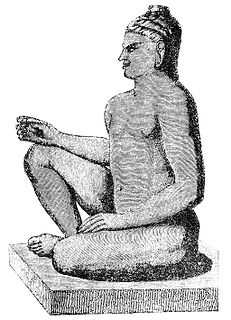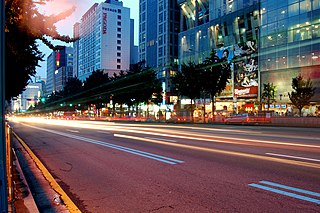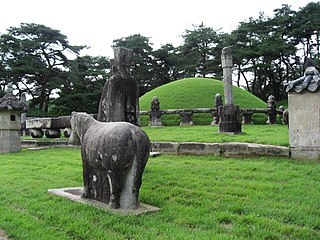Bukhansan Monument, was designated as the 3rd National Treasure of Korea on December 12, 1962. The stone monument was originally erected at Bibong Peak on Bukhan Mountain. It was subsequently moved to Gyeongbokgung Palace for safekeeping and is now displayed in the National Museum of Korea.
The rectangular monument is built on a two-story pedestal. Because the monument was exposed to the elements for 1400 years it has suffered weathering and erosion damage. It is currently 154 centimeters high and 69 centimeters wide.
The Bukhansan Monument was rediscovered in 1816 during the reign of Emperor Sunjo by Chusa Kim Jeonghui, a famous calligrapher.
The monument is valuable for the historical information inscribed on its surface. There are 12 lines with 32 characters per line in the Haeseoche style of Chinese calligraphy. The inscription praises the Silla King Jinheung's (540-575 CE) territorial expansion into the Han River valley and commemorates the occasion when the king came and inspected the new borders of his realm. The inscription explains why the monument was built, describes the achievements of King Jinheung, and also describes the royal retinue. While the exact date of when the monument was constructed is unclear because the era name is illegible, it is believed that the monument was constructed in 561 CE or 568 CE because the Changnyeongbi Monument and the Hwangchoryeongbi Monument were built on those dates respectively.

The Samjeondo Monument is a monument marking Joseon Korea's submission to Manchu Qing Dynasty in 1636 after the Second Manchu invasion of Korea. Its original name was Daecheong Hwangje Gongdeok Bi (大淸皇帝功德碑) which means the stele to the merits and virtues of the Emperor of Great Qing. Initially erected at Samjeondo, near the Sambatnaru crossing point of the Han River, it was thereafter buried and erected again several times. It is nowadays designated as the 101st Historic site of South Korea.

Changgyeong Palace is a palace located in Seoul, South Korea.

A National Treasure is a tangible treasure, artifact, site, or building which is recognized by the South Korean government as having exceptional artistic, cultural and historical value to the country. The title is one of the eight State-designated heritage classifications assigned by the administrator of the Cultural Heritage Administration (CHA) in accordance with the Cultural Heritage Protection Act after deliberation by the Cultural Heritage Committee.

Yasovarman I was an Angkorian king who reigned in 889–910 CE. He was called "Leper King".

The Karla Caves, Karli Caves, Karle Caves or Karla Cells, are a complex of ancient Buddhist Indian rock-cut caves at Karli near Lonavala, Maharashtra. It is just 10.9 Kilometers away from Lonavala. Other caves in the area are Bhaja Caves, Patan Buddhist Cave, Bedse Caves and Nasik Caves. The shrines were developed over the period – from the 2nd century BCE to the 5th century CE. The oldest of the cave shrines is believed to date back to 160 BCE, having arisen near a major ancient trade route, running eastward from the Arabian Sea into the Deccan.
Kim sammaekjong was the 24th monarch of Silla, one of the Three Kingdoms of Korea.

Seonunsa is a head temple of the Jogye Order of Korean Buddhism. It stands on the slopes of Dosolsan in Asan-myeon, Gochang County, near the Yellow Sea coast in western Jeollabuk-do province.

Seodaemun District is one of the 25 districts of Seoul, South Korea.

Wongaksa Pagoda is a twelve metre high ten storey marble pagoda in the center of Seoul, South Korea. It was constructed in 1467 to form part of Wongaksa temple, that King Sejo had founded two years before on the site of an older Goryeo-period temple, Heungbok-sa. The temple was closed and turned into a kisaeng house by the king known as Yeonsan-gun, and under his successor, King Jungjong the site was turned into government offices. The pagoda and a memorial stele commemorating the foundation of Wongaksa alone survived. The site of the temple was later occupied by houses. During the Imjin War of the 1590s, the top portion of the pagoda was pulled down and lay on the ground at the foot of the pagoda until it was replaced by American military engineers in 1947.

The Bell of King Seongdeok is a large bronze bell, the largest extant bell in Korea. The full Korean name means "Sacred Bell of King Seongdeok the Great." It was also known as the Emile Bell, after a legend about its casting, and as the Bell of Bongdeoksa Temple, where it was first housed.

Seokgatap is a stone pagoda in South Korea designated as the 21st National Treasure on December 12, 1962. Its full name is Sakyamuni Yeoraesangjuseolbeop Tap, and is sometimes referred to as the Shadowless Pagoda or the Bulguksa Samcheung Seoktap.

The Stele of Bongseon Honggyeongsa Temple was designated as the seventh National Treasure of Korea on December 12, 1962.

Wongudan Altar, located in Jung-gu, Seoul, South Korea, was built in 1897 to serve as a site for the performance of the rite of heaven. The site was also known by other names, such as Hwangudan, Jecheondan and Wondan. Wongudan was designated South Korea's Historic Site No. 157 on July 15, 1967.

The Tombs of the Joseon Dynasty refers to the 40 tombs of members of the Korean Joseon Dynasty (1392–1910). These tombs are scattered in over 18 locations across South Korea. They were built to honor and respect the ancestors and their achievements, and assert their royal authority. The tombs have been registered as a UNESCO World Heritage site since 2009.

The Yeongeunmun was a historical gate located in present Hyeonjeo-dong, Seodaemun-gu, in the northwestern part of Seoul, South Korea. It was built in front of Mohwagwan during the Joseon dynasty where envoys dispatched from Ming and Qing China were received as diplomatic guests.

Tapgol Park, formerly Pagoda Park, is a small public park located at 97 Jongno (street), Seoul, South Korea. This park was once a site of Wongaksa. The word tap means "pagoda", and the park gets its name from the Wongaksa Pagoda, a 10 storied stone pagoda located in the park.

Seogang Bridge or Grand Seogang Bridge is a bridge over the Han River in Seoul, South Korea. The bridge links the Mapo and Yeongdeungpo districts. It is supported in the middle as it passes over the island of Bamseom.

Gojan Station is a commuter train station on Seoul Subway Line 4 in Ansan, Korea. It is the closest station to Ansan Wa~ Stadium. The alternate station name is Korea University Ansan Hospital Station. The word "Gojan" originated as "inside of cape".

The Bukhansanseong is a fortress located in Gyeonggi-do and Seoul, South Korea, dating back to the middle Joseon period. The present fort was completed in 1711, though plans for the structure date back to 1659. The name is also given to a fortress mentioned in the Samguk Sagi, constructed by Gaeru of Baekje in 132 CE, and the two are often conflated although the putative connection is contested.
The Kaesong Chomsongdae Observatory is located in Songak-dong, Kaesong, North Korea. It was an astronomical observatory during the Koryo period. Now only a granite platform remains, the sides of which coincide with the main cardinal points.


















